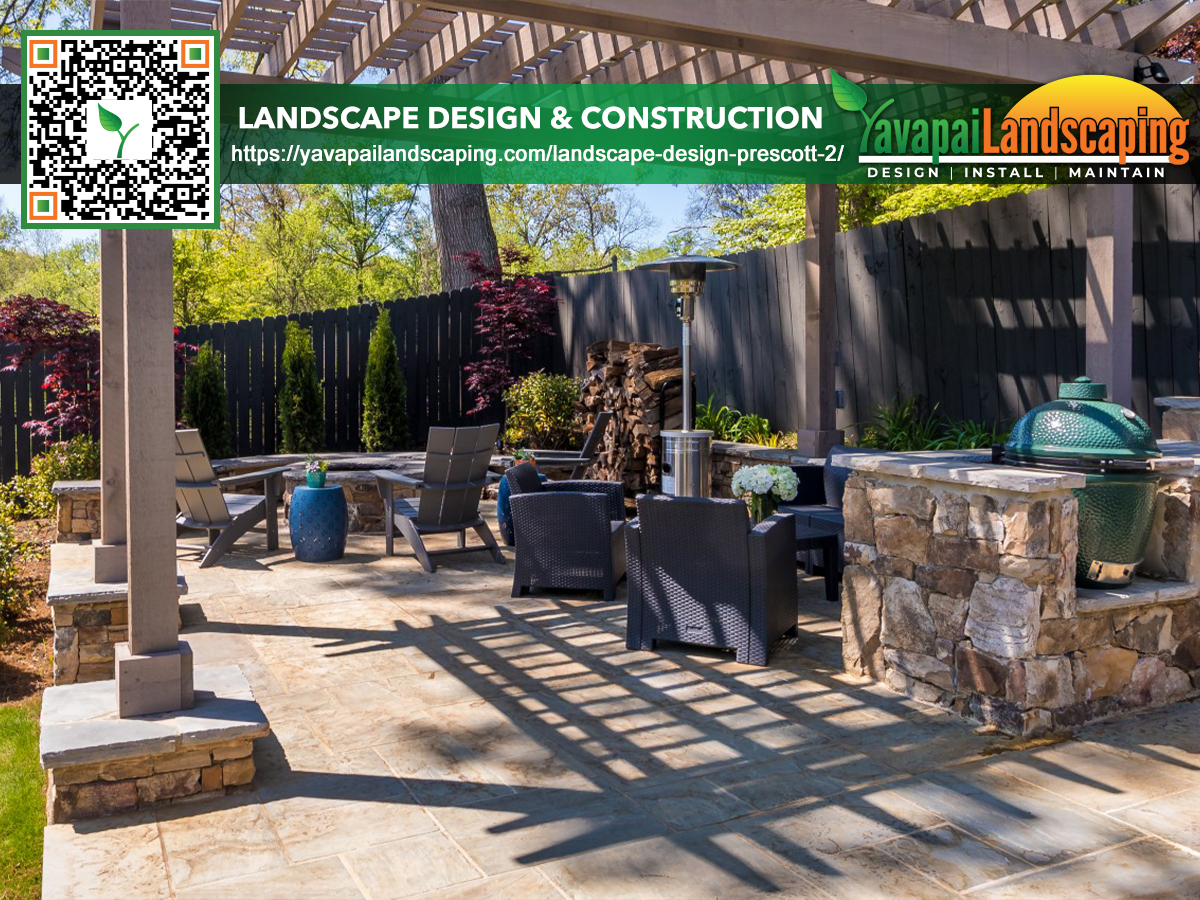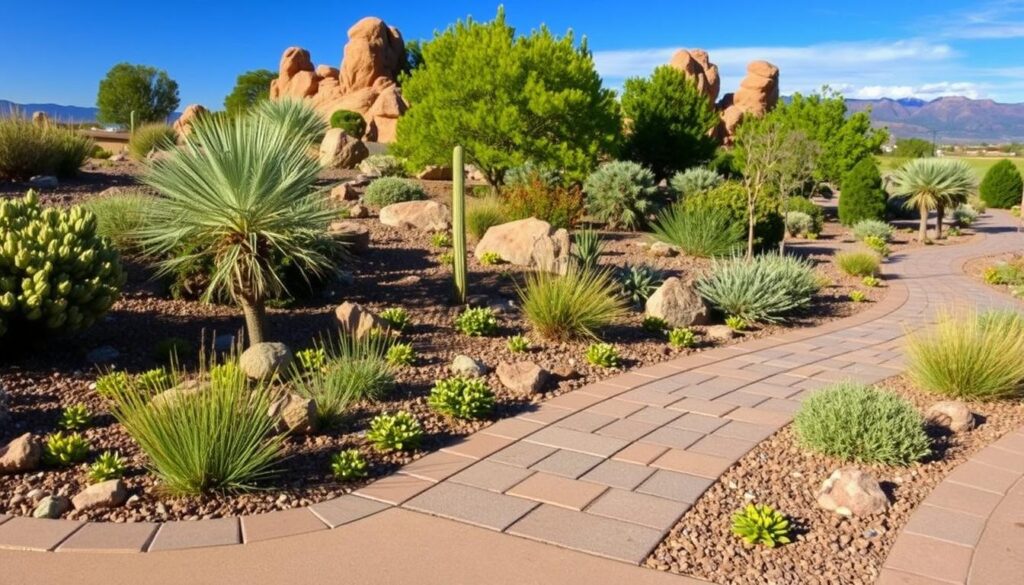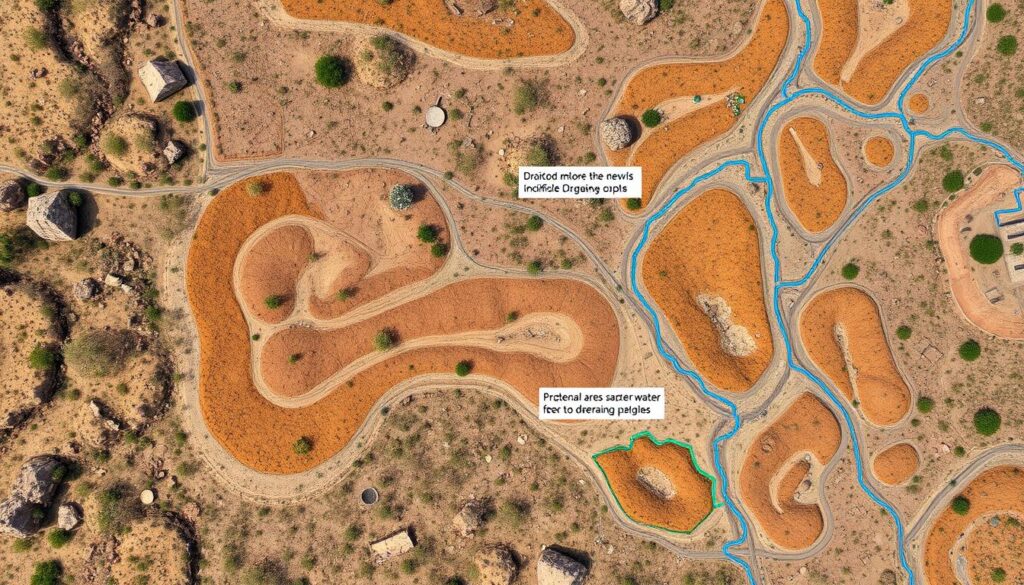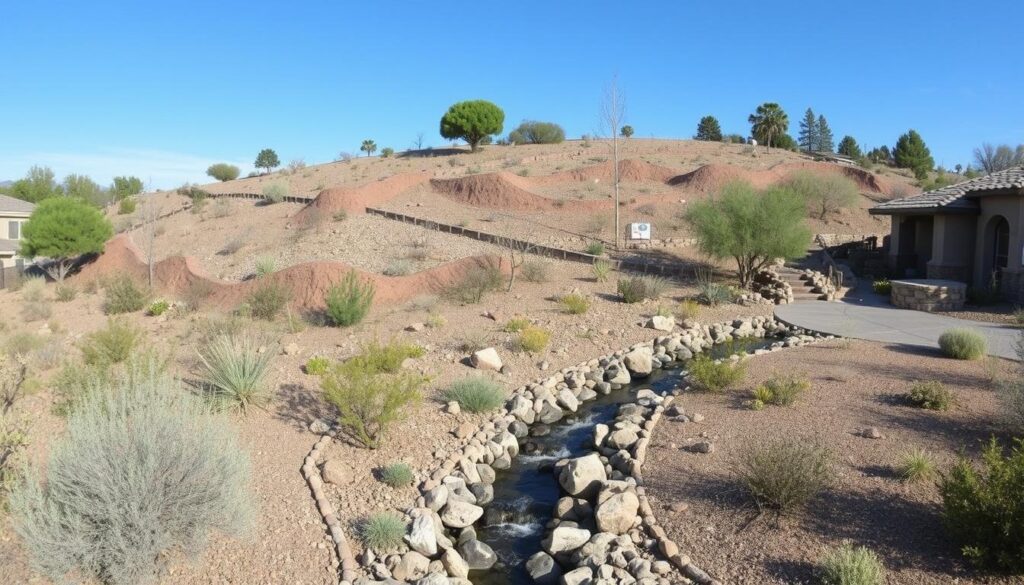
Proper landscape drainage and water management are key for any Prescott landscaping project. Without good drainage, your outdoor spaces can become a problem. This can cause water damage, unhealthy plants, and soil erosion.
To keep your landscape looking good and working well, focus on drainage from the start. This includes design, construction, and upkeep.
In Prescott, AZ, the land and soil types make drainage harder. Knowing these challenges and using the right drainage methods can make your landscape beautiful and safe from water damage.
Key Takeaways:
- Proper drainage is vital for preventing water damage, maintaining plant health, and reducing erosion in Prescott landscaping projects.
- Assessing site conditions and soil types is essential for designing effective drainage solutions.
- Incorporating swales, berms, French drains, catch basins, and permeable surfaces helps manage water flow in outdoor spaces.
- Integrating drainage elements with hardscapes and rain gardens creates a harmonious and functional landscape design.
- Regular maintenance of drainage systems ensures long-term effectiveness and prevents potential issues.
Understanding the Importance of Proper Drainage in Landscaping

Effective drainage is key in landscape design and construction. It keeps outdoor spaces healthy, functional, and beautiful. It prevents water damage, supports plant growth, and reduces soil erosion and runoff. Landscape experts use drainage techniques to create lasting, sustainable landscapes.
Preventing Water Damage to Structures
Proper drainage is crucial to avoid water damage to structures. Water near foundations, walls, patios, or other built elements can cause problems. These include structural damage, mold growth, and pest infestations.
By using grading, drainage systems, and water management, experts protect structures. They keep water away from critical areas, preventing damage and moisture issues.
Maintaining Healthy Plant Growth
Soils need good drainage for healthy plant growth. Poor drainage can lead to root rot, nutrient deficiencies, and stunted growth. It can also deprive plants of oxygen, causing decline or death.
Experts ensure water drains well, allowing plants to get the right moisture, oxygen, and nutrients. This promotes deep root growth, enhances plant resilience, and reduces disease and pest risks.
Reducing Soil Erosion and Runoff
Drainage systems are vital in controlling soil erosion and runoff. Heavy rainfall or irrigation can overwhelm poorly drained sites, causing runoff. This can erode topsoil, carry away nutrients, and damage hardscapes.
Drainage solutions like swales, berms, French drains, and permeable surfaces manage water flow. They slow down water, encourage infiltration, and direct excess water to collection areas. This helps maintain soil health, preserves landscape integrity, and improves water quality. Uncover the brilliance of this article by giving it a read.
Assessing Site Conditions and Soil Type
Before starting any landscape drainage project, it’s key to do a full site assessment and soil analysis. These steps give you important details about your property. They help you plan a drainage system that fits your needs perfectly.
Conducting a Site Survey
A detailed site survey is the first step to a good drainage system. It involves looking closely at your property. You’ll find out where water flows, low spots and problem areas are.
This info helps you decide where to put drainage elements. It makes sure they match your landscape’s shape and features.

Identifying Soil Composition and Permeability
Knowing your soil’s type and how it drains is crucial. Soils like clay, silt, and sand drain water differently. Soil analysis and testing tell you what your soil is like. This helps you pick the right materials and methods for your drainage system.
When checking the soil, think about:
- Soil texture and structure
- Organic matter content
- Soil pH levels
- Presence of rock or hardpan layers
These details help you plan a drainage system. It will manage water flow, help plants grow, and prevent soil erosion and runoff.
Also, think about other site conditions that affect your drainage system. These include:
- Slope and gradient of your property
- Existing vegetation and root systems
- Proximity to water sources, such as streams or ponds
- Sunlight exposure and shade patterns
By doing a full site assessment and soil analysis, you get the info needed. You can design a drainage system that solves your property’s problems. It will also make your property look better and work better.
Designing Effective Drainage Solutions
Creating a beautiful and functional landscape is key. Effective drainage solutions are crucial. By using different techniques and materials, your outdoor spaces in Prescott, AZ, can stay safe from water damage. They can also stay healthy and look great. Let’s look at some important strategies for good drainage.
Incorporating Swales and Berms
Swales and berms are vital for landscape drainage. Swales are shallow, linear depressions that guide water to specific spots. This helps prevent soil erosion and stops water from pooling where it shouldn’t. Berms, on the other hand, are raised mounds of soil. They can divert water or act as barriers. Strategically placed, they keep water away from buildings and plants.
Utilizing French Drains and Catch Basins
French drains and catch basins are great for underground water management. A French drain has a perforated pipe surrounded by gravel. It lets water in and carries it away from trouble spots. It’s great for low-lying or poorly-draining areas. Catch basins collect surface water and sediment before sending it to a pipe. They prevent clogs and ensure water is moved efficiently.
Implementing Permeable Pavers and Surfaces
Permeable pavers and surfaces let water pass through and soak into the soil. Unlike hard surfaces, they don’t cause runoff. They come in many styles and colors, making them perfect for patios, walkways, and driveways. Using them helps manage water while keeping your outdoor space beautiful and functional.
When designing your drainage system, think about your site’s unique features. Consider soil type, topography, and climate. By using swales, berms, French drains, catch basins, and permeable pavers, you can protect your property. You’ll also support healthy plants and enhance your landscape’s beauty in Prescott, AZ.
Landscape Drainage Considerations
When planning drainage for your landscape in Prescott, AZ, consider the local climate and weather. Prescott sees heavy rain and long, dry spells. Your drainage system must handle both extremes well.

It’s also key to know local building codes and regulations. These rules might affect your drainage system’s design and setup. They cover stormwater management, grading, and materials. Following these rules helps avoid problems and ensures your system works well for years.
For the best outcome, tailor your drainage plan to your property’s unique needs. Think about:
- The size and layout of your landscape
- The location of structures and utilities
- Soil composition and permeability
- Desired aesthetic and functionality of your outdoor space
By carefully considering these factors, you can choose and place drainage components wisely. This will manage water flow, protect your landscape, and make your Prescott property more beautiful.
Integrating Drainage with Landscape Features
Effective landscape integration means adding drainage elements to the design. This makes the outdoor space look good and work well. By matching drainage with hardscapes and using rain gardens or bioretention, homeowners can keep plants healthy and protect buildings from water damage.
Harmonizing Drainage Elements with Hardscapes
Hardscape design is key in landscape integration. It can blend with drainage systems to guide water flow. This keeps outdoor spaces both functional and attractive. When planning hardscapes like patios and walkways, remember:
- Make sure water flows away from buildings and toward drainage features
- Choose materials that let water soak in, like porous pavers or gravel
- Add decorative touches, like river rock or plants, to make drainage areas look nice
Creating Rain Gardens and Bioretention Areas
Rain gardens and bioretention areas are vital for water-wise landscaping. They catch and clean stormwater runoff, making the landscape look better. These shallow spots are placed where water tends to collect. They’re filled with native plants that handle both wet and dry conditions. When setting up rain gardens or bioretention areas, remember:
- Pick plants that fit the local climate and soil and can handle wet and dry times
- Make the rain garden slightly lower than the rest of the landscape to draw in water
- Use different plant heights, textures, and colors to add interest and attract wildlife
- Add mulch to keep moisture in, stop weeds, and control soil temperature
By blending drainage with hardscapes and making rain gardens or bioretention areas, homeowners in Prescott, AZ, can create a landscape. This landscape manages water well and makes outdoor spaces more beautiful and useful.
Maintenance and Upkeep of Drainage Systems
To keep drainage systems in Prescott, AZ landscapes working well, regular care is key. Homeowners and landscapers should check the systems often. This helps spot damage, clogs, or erosion in parts like catch basins and French drains.
Fixing problems quickly is important. It stops small issues from becoming big ones that harm the whole system.
Keeping drains clean is also vital. Leaves, twigs, and sediment can block them over time. A regular cleaning schedule keeps the system running smoothly. It also stops water from pooling in the yard.
It’s important to watch for signs of erosion too. Soil that’s unstable or too much runoff can be a problem. If you see these signs, you might need to add erosion control measures.
These could include blankets, ripraps, or changes to the drainage design. Being proactive with maintenance helps keep systems working well. This has protected outdoor spaces in Prescott, AZ, for many years.
Yavapai Landscaping Prescott offers complimentary estimates for Prescott and its surrounding communities for Landscaping and tree Services. This includes tree removal, trimming, stump grinding, land clearing, storm clean-up, and emergency tree services.
